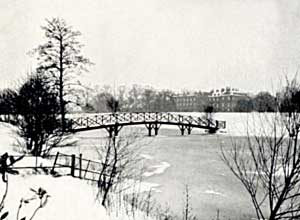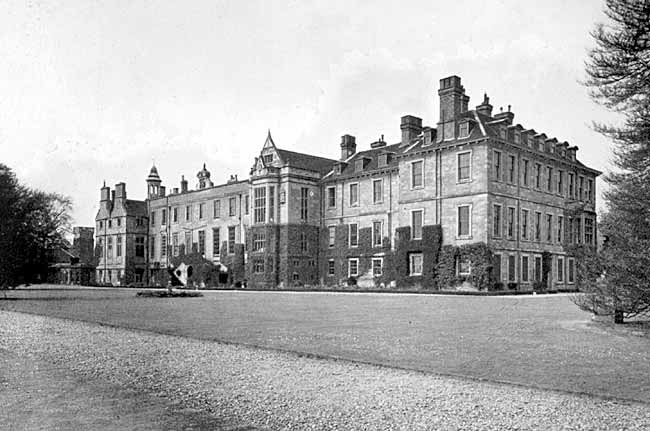
From the Lake.
The principal approach to Rufford Abbey is by the lodge on the Nottingham road. A fine stone gateway, surmounted by the arms of the family, opens on a once grand avenue of limes. They have, alas! suffered severely in the gales of recent years, and more than one of these decrepid old giants now depends on the doubtful support of his neighbour. As you descend this avenue the west front of the house gradually becomes visible, with its quaint gables and mullioned windows. This is the decayed front of the old abbey alluded to above. A bridge connects the carriage drive with a fine stone portal with twisted columns, the door of which opens on a lobby of carved oak panels with a collection of curious old weapons and armour. Three steps lead you into the ancient Banqueting Hall with floor of red brick in mosaic devices. A dado of dark oak panelling runs round the hall, and on it hang pictures of the Tudor period, portraits of Arabella Stuart as a girl, of Sir William and Lady Savile the heroine of Sheffield Castle, and several of the Sidney family. Above the dado the walls are covered with tapestries of the Flemish school. Across the hall near the entrance is an oaken screen carved with quaint Elizabethan tracery. Beyond the arches at either end of the screen stand men in armour placed in front of Gothic tapestry. Above their helmets rises the minstrels' gallery. Along the whole length of the hall, under the windows, runs a narrow oak table blackened with age, a relic of the Cistercian monks, together with the benches used by them at their meals. In the centre of the hall is an enormous fireplace of stone, with Elizabethan carving. Crossing the dais at the upper end, you find the door leading to the Library, a fine room with a ceiling of great beauty. Above the bookcases the walls are covered with rich red velvet brocade, forming a good background to the pictures and china. Over the large stone fireplace hangs a fine portrait of the Prince of Wales in Garter robes, painted by the late Augustus Savile, H.M. Marshal of the Ceremonies, who, besides being of great social fame, was, like his brother the late Lord Savile, an artist of considerable talent.
The Drawing-room walls and ceiling are decorated with carvings of flowers, medallions and ribbons in white and gold, and the walls are panelled with crimson and white silk of the basket pattern. The furniture is entirely covered with exquisite specimens of Gobelin and Beauvais tapestry of the Louis XV. period.
The Billiard-room contains many interesting family portraits, among others that of the sixth Earl of Shrewsbury, the husband of Bess of Hardwick; Sir Henry Savile, provost of Eton in the reign of Queen Elizabeth, and founder of the Savilian fellowship at the University of Oxford, by Marcus Garrett; a magnificent portrait of Strafford by Vandyke; Barbara, Countess of Scarborough, by Sir Joshua Reynolds; Lord Halifax, by Sir J. Kneller, and both his wives by Sir P. Lely; Prince Rupert by Lely, and Lady Savile by Romney.
The Picture Gallery or Ball-room, which forms part of the wing built by Lord Halifax, is 124 ft. in length, with floor of oaken parquet, and a ceiling copied from one at Hardwick. On the walls of one side of this fine room hang pictures by Velasquez, Rembrandt, Terriers, Vandyke, Murillo, Watteau, Greuze and Gainsborough ; the other side is entirely covered with fine specimens of Brussels tapestry.
The Dining-room is, perhaps, the least imposing one of the house, but it contains some noteworthy pictures and family portraits, besides a magnificent collection of racing cups, mostly trophies by the late Mr. Henry Savile, whose celebrated horse Cremorne won the Derby of 1872.
The grand staircase, of carved oak, was designed and built by the late Lord Savile, H.M. Ambassador at Rome; the fine bay window, which forms the first landing, being the only addition to the outside of the house since the alterations made by Lord Halifax. The windows of this landing are coloured with the coats of arms of the family from the time that Sir George Savile obtained the property through his marriage with Lady Mary Talbot in 1590. A smaller oak staircase leads down to the Chapel, the date of which in its present state is uncertain; but it clearly existed in the time of Bess of Hardwick, for there, as already mentioned, was celebrated her daughter's marriage to Charles Stuart in 1574. Its walls are covered with tapestry, and the pews of very black oak are surmounted by handsomely carved finials. The large gallery above, which forms the pew of the family, contains no prayer-books of more recent date than that of Charles II. In the floor of the aisle is a tombstone with a cross incised and an inscription in Latin, "Robert de Markham, a monk of this house who died in 1309,"—but this slab was no doubt placed in the chapel at a later period.
Descending from the family pew by a stone staircase, you come to the basement floor. It was at the foot of this staircase that, about thirty years ago, on removing some large flags which always seemed damp, a skeleton was found with a bullet hole through the skull. The bones were removed to Wellow churchyard and buried there. Past the lower door of the Chapel and along a stone corridor, you come to the Servants' Hall; this was the old crypt of the abbey, an immense hall with vaulted roof, huge columns of stone, and a fireplace of colossal dimensions.
The cellars which adjoin the crypt are extremely interesting, being of the same architecture but entirely unaltered since the days of the monks; the walls throughout this portion of the house are 6 ft. in thickness.
But the bedroom floor is what appears more than all to attract the admiration of visitors to Rufford. Many of these rooms are hung with splendid specimens of Brussels tapestry made specially for them. In the Stuart Room, where both the Charleses slept, these represent the history of Queen Esther. In the State-room scenes from the life of Marcus Aurelius adorn the walls. The furniture in most of the bedrooms is French of the Louis XIV. and XV. periods.
Rufford has always had the reputation of being haunted; and though the present owner, after many years' residence, can add no testimony of his own on the subject, there are several persons of undoubted veracity still living who affirm that they have seen "the little old lady in black." More recently great alarm was occasioned to one of the guests by a visit from a gigantic monk with a death's head under his cowl. Whatever the explanation of these mysterious appearances may be, it is certain that the belief in them was both wide-spread and widely credited; for among the early registers of the parish church at Edwinstowe was entered the burial of a man who "died from fright after seeing the Rufford ghost."
The park is undulating and finely wooded. Round the house tall fences of yew and of holly are cut into fantastic shapes. Three streams run through the garden, and wind their way into a lake dotted with islands with fine old clumps of trees upon them. Below a winter garden filled with immense palms rises a fountain, which flows into the ancient stew or fishpond bordered with daffodils. Here, when in the mood for dreaming, we can picture to ourselves the white-clad forms of the Cistercian brothers, engaged in the absorbing pursuit of procuring their Friday's meal, while not forgetting, let us hope, to breathe a prayer for the soul of their departed benefactor, Gilbert of Gaunt.
SAVILE.

From the Lawn.
